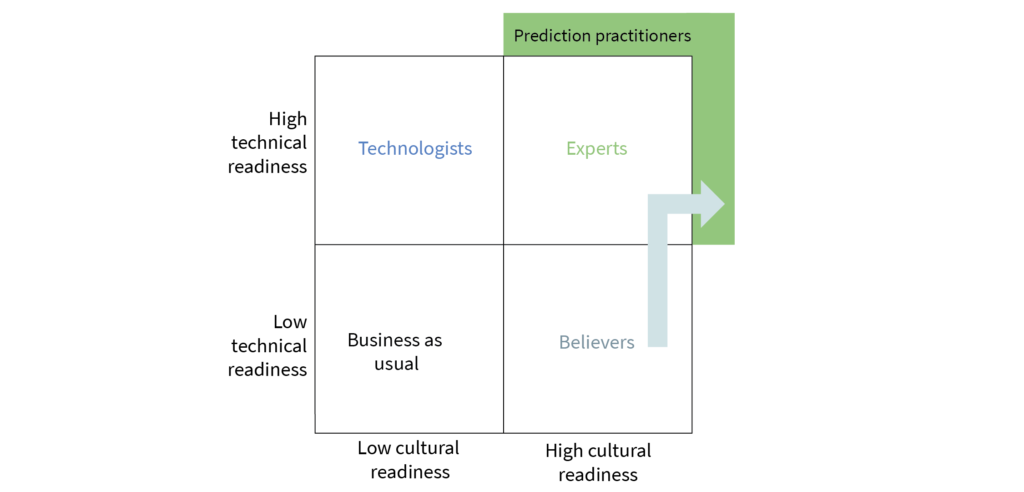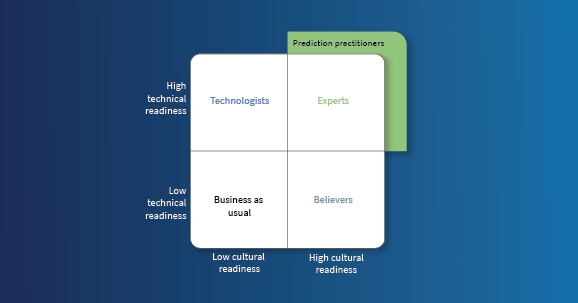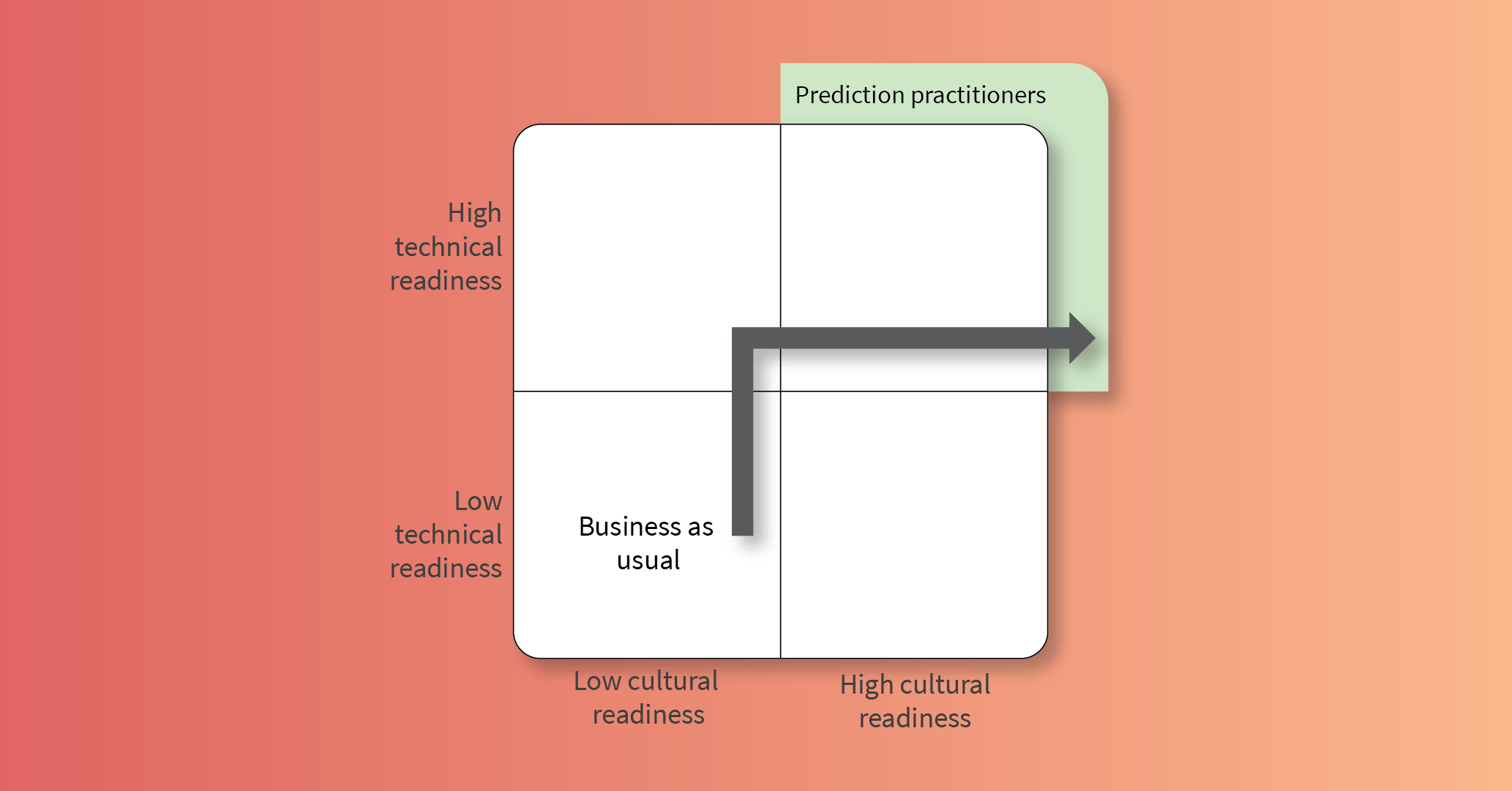Building a Solid Analytics Foundation from Lower Technical and Higher Cultural Readiness
Key takeaways:
- Starting from a low-high stance enables the organization to focus on the technical “how” rather than on the, often, more difficult cultural “why.”
- Simplify the “how” by choosing analytics tools that are easily deployed and that enable the operations team to do their work with a minimal learning curve.
- Use daily meetings to provide a consistent focus on learning and support for the inevitable technical challenges that arise.
If you’re new to this series, please read the introduction to building a solid analytics foundation before continuing.
The characteristics of a low technical readiness and high cultural readiness (low-high) organization are summarized below. Remember that this isn’t a judgement, a grade or a level. This is just a convenient label for describing where an organization might start in its quest to implement predictive analytics.
Based on our experience with customers starting from this state, we believe that an effective approach to becoming predictive practitioners is to leverage the existing belief in data by using the minimal technology needed to show how meaningful progress can be made. This is shown schematically in figure 1 below.

Starting from a low-high stance provides an important advantage
One of the more challenging aspects of harnessing data analytics is to build belief that such things are needed – If we have gotten along all this time without it, why do we need it now? Instead of fighting that inertia, organizations starting from low-high are able to use the sentiment that data is important to their advantage. This means such organizations can focus on understanding the mechanics of how to make technology useful rather than on the cultural battle of changing hearts and minds.
The first step is to identify and deploy the minimum set of analytics technologies which let the organization show that progress can be made. As in the low-low case, this is not the time to invest in the latest-and-greatest, cutting edge, highly customizable, data scientist-focused technology. With that kind of power and flexibility comes a very steep learning curve. For a low technology readiness organization, deferring the steep part of that learning curve is important. Getting quick wins using simpler, standard functionalities are key to showing feasibility. Some characteristics of analytics tools to look for is that they:
- Describe what equipment or processes are doing using visualization and pattern detection – especially detection of anomalous patterns of activity.
- Include a basic capability to summarize findings (e.g. compute averages, standard deviations, etc) and alert on simple rules, like thresholds.
- Make it easy to quickly generate reports that can be used in meetings. For example via dashboarding and adequate filtering or search tools to quickly arrive at the subset of data needed for a report.
- Are easy to deploy and integrate. Software as a Service (SaaS)-based platforms which support simple, common common formats (like CSV) and protocols (like MQTT) greatly simplify the startup process by removing the need for capital outlay and by minimizing IT involvement.
The next step towards building a solid analytics foundation
Once the tools are in place, the next step is to adopt practices that ensure at least one operations team uses this technology to openly engage data in their daily work. These daily meetings can achieve two things needed for success:
- Focus the team’s attention on using data every day even if only in small ways. Our experience with the Intelligence-first approach shows that a series of small insights lead to new questions. Questions lead to greater understanding and, eventually, to concrete examples of problems solved or issues avoided. The best way to encourage these kinds of seeds to grow is to water them gently every day.
- Highlight and overcome technical challenges with the analysis tool. When faced with a deadline to solve a problem and new technology to solve it with, it is common to default to solving the problem without the technology – Better to spend 4 hours getting something done with certainty than to spend 1 hour doing it without the confidence that it will work. However, because understanding and overcoming the technical barriers is a key element of successful transition for a low-high organization, this attitude cannot be allowed to persist. A well run daily meeting provides motivation to work on the hard things as well as a built-in support system for doing those hard things.
As experience with acting on data-driven findings grows and as people see that their beliefs about the utility of data were right, it becomes important to shift the emphasis from celebration to answering the question: “how do we expand usage of the technology to other groups and lines?” This means engaging management on specific technical or workflow related shortcomings that the daily meetings have surfaced. Questions like these can help: “Which techniques and tools are working? Which are not working and why? What usability factors are hampering adoption by certain groups or in certain areas of the plant? What reporting functions and integrations are missing which would make the findings fit more naturally into the existing workflows?” With experiences that reinforce the belief that data adds value and with a list of technical capabilities that would make people even more effective at using data, the organization has a solid foundation for pursuing more demanding or complicated analysis capabilities. At the end of this process, the executives should see that their beliefs in data were justified and that the existing teams can implement technology – the only question should be how to make that happen everywhere in the organization.
By choosing Falkonry’s time series AI as part of the basic technology deployed for this work, your operations teams will get software that is simple to deploy and that enables non-data specialists to work independently. This combination of traits and the Intelligence-first approach that it enables helps the organization learn the “how” of making analytics happen so that they can expand that “how” quickly and effectively.





